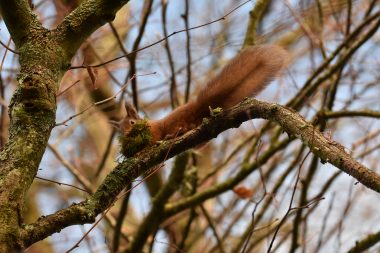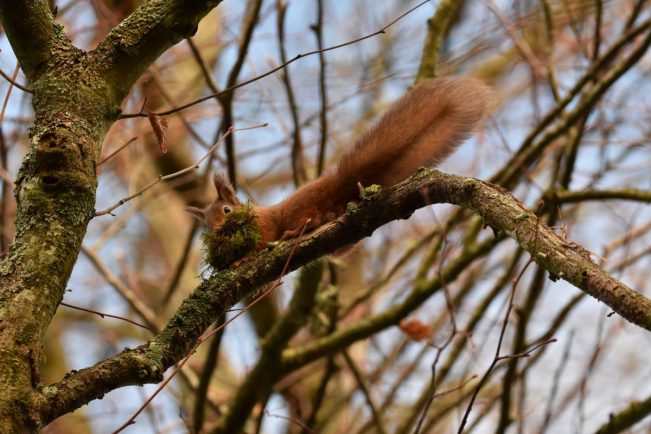Grey squirrels are preyed upon significantly more than red squirrels, with pine martens targeting greys exclusively in spring and summer, during their breeding season.
That’s according to new research by Queen’s University Belfast which shows that native European pine martens (Martes martes) prey on non-native grey squirrels (Sciurus carolinensis) significantly more than red squirrels (Sciurus vulgaris).
The findings, published in Mammalian Biology earlier this year and funded by UK wildlife charity People’s Trust for Endangered Species (PTES), also show that although both squirrel species are on the pine martens’ menu, pine martens prey on grey squirrels exclusively in spring and summer, during the squirrels’ breeding season.
 A native pine marten. Picture credit: Dr. Joshua P. Twining.
A native pine marten. Picture credit: Dr. Joshua P. Twining.As such, it’s now thought pine martens may raid grey squirrel nests (known as ‘dreys’), specifically targeting juveniles and females caring for young.
This provides a plausible mechanism for the decline in grey squirrels seen across Ireland and Britain.
The research, led by Dr. Joshua Twining from the School of Biological Sciences at Queen’s University Belfast, also showed that pine martens do predate on native red squirrels, but at a much lower level.
Red squirrels have adapted to live alongside pine martens in the evolutionary landscapes of Europe, thus, red squirrels appear to have a greater awareness of the threat posed by pine martens.
Grey squirrels may also be energetically more valuable, and therefore preferable to predators like pine martens as they are larger and are found in higher numbers than red squirrels.
Dr. Joshua P. Twining, from the School of Biological Sciences at Queen’s University Belfast, adds: “Our findings align with the evolutionary physiology and morphology of many small carnivores – slim and slender, pine martens are adapted to pursue prey into small ‘hidey holes’, such as dreys, that other predators cannot access.
“With semi-retractable claws, and extremely flexible joints which can turn almost 180 degrees, pine martens have evolved to climb.
 A native red squirrel. Picture credit: Dr. Joshua P. Twining.
A native red squirrel. Picture credit: Dr. Joshua P. Twining.“Although such adaptations make pine martens less efficient at chasing down prey, being the only arboreal predator in Great Britain and Ireland gives them easy access to the refuges of squirrels high up in trees.
“Our results are interesting as they help explain the mechanism underpinning how pine martens are able to regulate invasive grey squirrel populations, and give a much-needed boost for another one of its prey species, our native red squirrels.”
This magnificent yet mysterious member of the mustelid family is native to Britain and was once one of the most abundant predators in the country.
Now, after centuries of widespread persecution and habitat loss, most recent estimates suggest there are only around 3,000 in Ireland and 9,000 in Great Britain, with only approximately 100 thought to be living in England.
Just last week, pine martens were listed as ‘Critically Endangered’ on the Red List for England’s mammals.
Nida Al-Fulaij, Grants Manager at PTES, says: “Results like Joshua’s are a ray of hope for this beautiful species, as not only are pine martens naturally helping to reduce numbers of non-native, introduced species such as grey squirrels (one of the main threats to our native red squirrels), but also as their numbers are finally starting to recover in parts of Britain and Ireland too.
It’s important that we understand exactly how pine martens are faring, which includes their predation habits. Pine martens are desperately in need of our help, but this is very positive step forward in our understanding of this species, which ultimately will help us to conserve them long term.”
Over the last 40 years PTES has awarded £7.5million to conservation research, supporting over 200 species in more than 60 countries and funding 102 internships since 2002.
The charity’s intern alumni include conservationists working for universities (such as Joshua), wildlife NGOs and ecological consultancies.
The work of previous PTES funded interns includes work on DNA extraction and identification to help stop the trade in endangered wildlife – a subject that is now more pertinent than ever.











